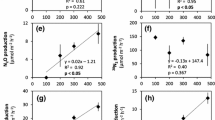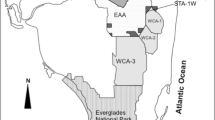Abstract
The use of periphyton nitrogenase activity (biological N2 fixation) as an indicator of wetland P impact was assessed using patterns of nutrient content (C, N, P, Ca, Mg, K, Fe, and Mn) and acetylene reduction (AR) in floating cyanobacterial periphyton mat (metaphyton) communities of a P-enriched portion of the Florida Everglades, USA (Water Conservation Area-2A, WCA-2A). Spatial patterns of nutrients indicate the enrichment of floating mat periphyton N, P, Fe, and K, and the reduction of Mn and TN:TP in enriched marsh areas. In highly enriched areas, floating mat periphyton AR was approximately threefold greater than that in less enriched, interior marsh zones. Multiple regression models indicated AR dependence on P in eutrophic WCA-2A areas while the AR of more interior marsh periphyton mats was more closely related to tissue levels of Ca and Fe. Nitrogenase activity of floating mat periphyton from P-loaded mesocosms revealed a significant enhancement of N2 fixation in samples receiving approximately 2–3 mg P m−2 of cumulative P dosing or with biomass TP content of 100–300 mg kg−1. At P contents above the optimum, mat periphyton AR was suppressed possibly as a result of changes in species composition or increased levels of NH +4 . After 3 years of dosing, consistently high AR occurred only at low rates of P enrichment (0.4–0.8 g P m−2 yr−1), and the patterns appeared to be seasonal. These findings agree with the hypothesis that P availability is a key determinant of nitrogenase activity in aquatic systems, and thus, may support the use of periphyton nitrogenase to indicate P impacts in P-limited systems. These results also demonstrate the potential existence of a P threshhold for biogeochemical alteration of periphyton mat function in the Everglades, and that cumulative loading of limiting nutrients (i.e., P), rather than instantaneous concentrations, should be considered when evaluating nutrient criteria.






Similar content being viewed by others
References
Bergmann MA, Welch HE (1990) Nitrogen fixation by epilithic periphyton in small arctic lakes in response to experimental nitrogen and phosphorus fertilization. Can J Fish Aquat Sci 47:1545–1550
Browder JA, Gleason PJ, Swift DR (1994) Periphyton in the Everglades: spatial variation, environmental correlates, and ecological implications. In: Davis SM, Ogden JC (eds) Everglades: the ecosystem and its restoration. St. Lucie Press, Delray Beach, FL
Craft CB, Richardson CJ (1997) Relationships between soil nutrients and plant species composition in everglades peatlands. J Environ Qual 26:224–232
Craft CB, Vymazal J, Richardson CJ (1995) Response of Everglades plant communities to nitrogen and phosphorus additions. Wetlands 15:258–271
Davis SM, Ogden JC (eds) (1994) Everglades: the ecosystem and its restoration. St. Lucie Press, Del Ray Beach, FL
Diaz MR, Corredor JE, Morell JM (1990) Nitrogenase activity of Microcoleus lyngbyaceus mat communities in a eutrophic tropical marine environment. Limnol Oceanogr 35:1788–1795
Elakovich SD, Spence S, Yang J (1999) Phytochemical inhibitors from Nymphaeceae: Nymphaea odorata and Nuphar lutea. In: Cutler HG, Cutler SJ (eds) Biologically active natural products: agrochemicals. CRC Press, pp 49–56
Flett RJ, Schindler DW, Hamilton RD, Campbell NER (1980) Nitrogen fixation in Canadian Precambrian shield lakes. Can J Fish Aquat Sci 37:494–505
Flora MD, Walker DR, Scheidt DJ, Rice RG, Landers DH (1988) The response of Everglades marsh to increased nitrogen and phosphorus loading. Part I: nutrient dosing, water chemistry, and periphyton productivity. Everglades National Park, Homestead, FL, USA
Gaiser EE, Trexler JC, Richards JH, Childers DL, Lee D, Edwards AL, Scinto LJ, Jayachandran K, Noe GB, Jones RD (2005) Cascading ecological effects of low-level phosphorus enrichment in the Florida everglades. J Environ Qual 34:717–723
Hall GB, Rice RG (1990) Response of the Everglades marsh to increased nitrogen and phosphorus loading. Part III: periphyton community dynamics. Everglades National Park, Homestead, FL, USA
Hendzel LL, Hecky RE, Findlay DL (1994) Recent changes of N2-fixation in Lake 227 in response to reduction of the N:P loading ratio. Can J Fish Aquat Sci 51:2247–2253
Horne AJ, Sandusky JC, Carmiggelt CJW (1979) Nitrogen fixation in Clear Lake, California. 3. Repetitive synoptic sampling of the spring Aphanizomenon blooms. Limnol Oceanogr 24:316–328
Inglett PW, Reddy KR, McCormick PV (2004) Periphyton chemistry and nitrogenase activity in a northern Everglades ecosystem. Biogeochemistry 67:213–233
Koch MS, Reddy KR (1992) Distribution of soil and plant nutrients along a trophic gradient in the Florida Everglades. Soil Sci Soc Am J 56:1492–1499
Kuo S (1996) Phosphorus. In: Sparks DL (ed) Methods of soil analysis, Part 3: chemical analysis. Soil Science Society of America Book Series No. 5. Madison, WI
Loeppert RH, Suarez DL (1996) Carbonate and gypsum. In: Sparks DL (ed) Methods of soil analysis, Part 3: chemical analysis. Soil Science Society of America Book Series No. 5, Madison, WI
McCormick PV, Cairns J Jr (1994) Algae as indicators of environmental change. J Appl Phycol 6:509–526
McCormick PV, O’Dell MB (1996) Quantifying periphyton responses to phosphorus in the Florida Everglades: a synoptic-experimental approach. J North Am Benthol Soc 15:450–468
McCormick PV, Stevenson RJ (1998) Periphyton as a tool for ecological assessment and management in the Florida Everglades. J Phycol 34:726–733
McCormick PV, Rawlik PS, Lurding K, Smith EP, Sklar FH (1996) Periphyton-water quality relationships along a nutrient gradient in the northern Florida Everglades. J North Am Benthol Soc 15:433–449
McCormick PV, Shuford RBE, Backus JB, Kennedy WC (1998) Spatial and seasonal patterns of periphyton biomass and productivity in the northern Everglades, Florida, USA. Hydrobiologia 362:185–208
McCormick PV, O’Dell MB, Shuford RBE, Backus JG, Kennedy WC (2001) Periphyton responses to experimental phosphorus enrichment in a subtropical wetland. Aquat Bot 71:119–139
Newman S, McCormick PV, Miao SL, Laing JA, Kennedy WC, O’Dell MB (2004) The effect of phosphorus enrichment on the nutrient status of a northern Everglades slough. Wetlands Ecol Manage 12:63–79
Noe GB, Childers DL, Jones RD (2001) Phosphorus biogeochemistry and the impact of phosphorus enrichment: why is the Everglades so unique? Ecosystems 4:603–624
Paerl HW (1990) Physiological ecology and regulation of N2 fixation in natural waters. Adv Microbiol Ecol 11:305–344
Paerl HW, Prufert LE, Bebout B, Guo CZ (1994) Iron-stimulated N2 fixation and growth in natural and cultured populations of the planktonic marine cyanobacteria Trichodesmium spp. Appl Environ Microbiol 60:1044–1047
Pinckney J, Paerl HW, Fitzpatrick M (1995a) Impacts of seasonality and nutrients on microbial mat community structure and function. Mar Ecol-Prog Ser 123:207–216
Pinckney J, Paerl HW, Reid RP, Bebout B (1995b) Ecophysiology of stromatolitic microbial mats, Stocking-Island, Exuma-Cays, Bahamas. Microb Ecol 29:19–37
Reddy KR, DeLaune RD, DeBusk WF, Koch MS (1993) Long term nutrient accumulation rates in the Everglades. Soil Sci Soc Am J 57:1147–1155
Reddy KR, Wang Y, Debusk WF, Fisher MM, Newman S (1998) Forms of soil phosphorus in selected hydrologic units of the Florida Everglades. Soil Sci Soc Am J 62:1134–1147
Reddy KR, White JR, Wright A, Chua T (1999) Influence of phosphorus loading on microbial processes in the soil and water column of wetlands. In: Reddy KR, O’Connor GA, Schelske C (eds) Phosphorus biogeochemistry in subtropical ecosystems. Lewis Academic, Boca Raton, FL, pp 249–273
Rejmankova E (2001) Effect of experimental phosphorus enrichment on oligotrophic tropical marshes in Belize, Central America. Plant Soil 236:33–53
Rejmankova E, Komarkova J (2000) A function of cyanobacterial mats in phosphorus-limited tropical wetlands. Hydrobiologia 431:135–153
Scott JT, Doyle RD, Filstrup CT (2005) Periphyton nutrient limitation and nitrogen fixation potential along a wetland nutrient-depletion gradient. Wetlands 25:439–448
Stal LJ (1988) Nitrogen fixation in cyanobacterial mats. Methods Enzymol 167:474–484
Swift DR, Nicholas RB (1987) Periphyton and water quality relationships in Everglades water conservation areas, 1978–1982. South Florida Water Management District #87-2, West Palm Beach, FL
White JR, Reddy KR (2000) Influence of phosphorus loading on organic nitrogen mineralization of Everglades soils. Soil Sci Soc Am J 64:1525–1534
Acknowledgements
This research was funded in part by the South Florida Water Management District (SFWMD). The authors thank the following for their cooperation in this work: Q. Clark (University of Florida, UF), M. O’Dell, and C. Kennedy (SFWMD) for field assistance, and Y. Wang (UF) for laboratory analyses.
Author information
Authors and Affiliations
Corresponding author
Rights and permissions
About this article
Cite this article
Inglett, P.W., D’Angelo, E.M., Reddy, K.R. et al. Periphyton nitrogenase activity as an indicator of wetland eutrophication: spatial patterns and response to phosphorus dosing in a northern Everglades ecosystem. Wetlands Ecol Manage 17, 131–144 (2009). https://doi.org/10.1007/s11273-008-9095-5
Received:
Accepted:
Published:
Issue Date:
DOI: https://doi.org/10.1007/s11273-008-9095-5




